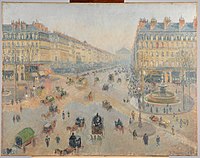
Photo from wikipedia
BACKGROUND AND OBJECTIVES Characteristics of a neighborhood's built environment affect the walking behavior of older people, yet studies typically rely on small nonrepresentative samples that use either subjective reports or… Click to show full abstract
BACKGROUND AND OBJECTIVES Characteristics of a neighborhood's built environment affect the walking behavior of older people, yet studies typically rely on small nonrepresentative samples that use either subjective reports or aggregate indicators from administrative sources to represent neighborhood characteristics. Our analyses examine the usefulness of a novel method for observing neighborhoods-virtual observations-and assess the extent to which virtual-based observations predict walking among older adults. RESEARCH DESIGN AND METHODS Using Google Street View, we observed the neighborhoods of 2,224 older people and examined how characteristics of the neighborhood built environments are associated with the amount of time older people spend walking for leisure and purpose. RESULTS Multilevel model analyses revealed that sidewalk characteristics had significant associations with both walking for purpose and leisure. Land use, including the presence of multifamily dwellings, commercial businesses, and parking lots were positively associated with walking for purpose and single-family detached homes were negatively associated with walking for purpose, but none of these characteristics were associated with leisure walking. Gardens/flowers were associated with walking for leisure but not purpose. Garbage/litter was not associated with either type of walking behavior. DISCUSSION AND IMPLICATIONS Virtual observations are a useful method that provides meaningful information about neighborhoods. Findings demonstrate how neighborhood characteristics assessed virtually differentially impact walking for leisure and purpose among older adults and are interpreted within a social-ecological model.
Journal Title: The Gerontologist
Year Published: 2019
Link to full text (if available)
Share on Social Media: Sign Up to like & get
recommendations!